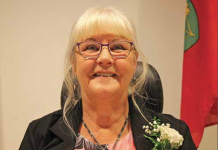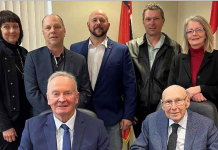While growing up in West Guilford, Bernie Nicholls recalls his parents, George and Marge, thinking he’d make a better juvenile delinquent than a National Hockey League (NHL) star.
The retired centreman, who put up 1,209 points in 1,127 games for the Los Angeles Kings, New York Rangers, Edmonton Oilers, New Jersey Devils, Chicago Blackhawks, and San Jose Sharks, appeared at the Minden library Sept. 9 for a Q&A organized by the Friends of the Haliburton County Public Library dissecting some of the finer, and lesser-known points of his 17-year career.
Like where he got his nicknames – plural. Most know about ‘Broadway Bernie’, the moniker famously used by former Toronto Maple Leaf Tie Domi and Gary Suter, a teammate in Chicago, in reference to Nicholls’ fashion choices. But there’s also ‘Pumpernickel’, first coined by commentator Bob Miller.
“That came about after a game in Edmonton when I was with LA. I scored an empty-net goal to make it 10-8 and I go from one end to the other celebrating. Bob called it the pumpernickel and it just stuck,” Nicholls said.
He adopted the move as his own, becoming one of the first NHL players to have a recognizable celebration.
After being drafted in the fourth round, 73rd overall, by the Kings in 1980, he made the team the following season – slotting in as second line centre behind Hockey Hall of Famer Marcel Dionne.
The pair never really clicked as teammates. “I love Marc… but he was top dog there forever. Sometimes players don’t really like it, maybe, when someone new comes in who is going to take a little bit away from them. I felt that from Marc, so we weren’t as close as we probably should have been,” Nicholls said.
The Great One
It was the total opposite when the Kings’ number 9 came face-to-face with the team’s new number 99 shortly after that fateful day Aug. 9, 1988, when LA acquired a certain Wayne Gretzky from the Edmonton Oilers in what remains one of the biggest trades in NHL history.
The two played together for about 18 months, paired on the Kings top powerplay and penalty kill units. Off the ice, they were almost inseparable, Nicholls recalls.
“Our relationship was awesome. Wayne knew it was such a big trade, he couldn’t do everything himself. He knew he needed help, and I was one guy who could help him,” Nicholls said. “We hung out every day. We went on the road and it was Wayne and I, nobody else. Everywhere he went, I went with him,” Nicholls said.
Back then, ‘The Great One’ had a love for McDonald’s – there was no nutritional plan players had to follow, very little in the way of sport science. Not that it made any difference on the ice.
Nicholls said he knew Gretzky was great, but his appreciation for his new teammate skyrocketed once they took to the ice together.
“I always tell people; with Wayne you just have to expect the unexpected. I could be standing there with three guys around me and the next thing I knew, the puck hits my stuck and it’s going in. I’m just left wondering how that happened – he could pick a pass from anywhere,” Nicholls said.
“It was Wayne’s hockey smarts that set him apart. He didn’t shoot the puck hard, he didn’t skate really fast. He just thought the game better and passed the puck better than anybody else,” he added.
The pair remain close, with Gretzky penning the foreword for Nicholls’ book From Flood Lights to Bright Lights.
Trades
After getting to meet the likes of Muhammad Ali and Michael Jordan while in LA, Nicholls swapped ‘Tinseltown’ for ‘The Big Apple’ in 1989. While there, he became friends with Hollywood A-Lister Tom Hanks, who invited Nicholls to a taping of Saturday Night Live shortly after being traded.
He also got to know John Candy, Michael J. Fox, Kurt Russell and Goldie Hawn.
Nicholls enjoyed his brief stint in New York, recording 134 points in 119 games before being involved in another blockbuster transaction – this time to the Edmonton Oilers in October 1991, with Mark Messier going the other way.
“That kinda sucked, because I would have loved to have played with Mark,” Nicholls said, calling Messier the hardest player he ever faced.
Nicholls maintained a point-per-game pace in Edmonton, with 114 in 111 games. He was traded again in January 1993, moving back to the east coast to the New Jersey Devils, where he played with a young Martin Brodeur. Nicholls said he enjoyed his time with the Devils, but it was only after moving to the Chicago Blackhawks in the summer of 1994 that he found his favourite home.
While in the ‘Windy City’, Nicholls developed a close relationship with Chris Chelios, who he said was one of the first players to embrace being a top-level athlete.
“He’d work out, doing push ups and sit ups in the sauna every day. He was unbelievable,” Nicholls said. “Chicago was a great hockey town.”
Nicholls played out the final three years of his career with the San Jose Sharks before retiring in 1999.
Post-retirement
Despite living in some of the most desirable places on the continent, Nicholls maintains his primary residence on Pine Lake in West Guilford. He stays in touch with the game – playing in charity events and participating in speaking engagements.
In 2012, he was a member of the Kings’ coaching staff when they won the Stanley Cup. He remembers bringing the trophy home and taking it out on the canoe his father built for him. Don Popple, in attendance Monday, recalled Nicholls bringing the cup to Curry Motors.
“I asked him what he wanted for that – it was a good day for us, we sold about 15 cars… he didn’t want anything, so we made a donation to minor hockey instead,” Popple said. “He never forgot where he came from. He was always happy to give back.”
Having achieved his dream of playing for a Canadian franchise and going on to represent two Original Six teams, Nicholls is proud of what he achieved in the game. He remains one of only four players to put up at least 70 goals and 150 points in a single season, alongside Gretzky, Phil Esposito and former Pittsburgh Penguin Mario Lemieux.
Nicholls couldn’t hide his admiration when discussing Lemieux, who he said he and Gretzky believe to be the greatest NHL player of all time.
“The numbers Wayne put up were phenomenal, obviously. But if you look back at what Mario did, coming back from a back injury, from cancer, getting all the points he did, it was incredible,” Nicholls said. “I’m sure everyone watched the Canada Cup in 1989, that was Mario’s coming out party. We had the best players playing, but Mario, nobody was close to him.”





